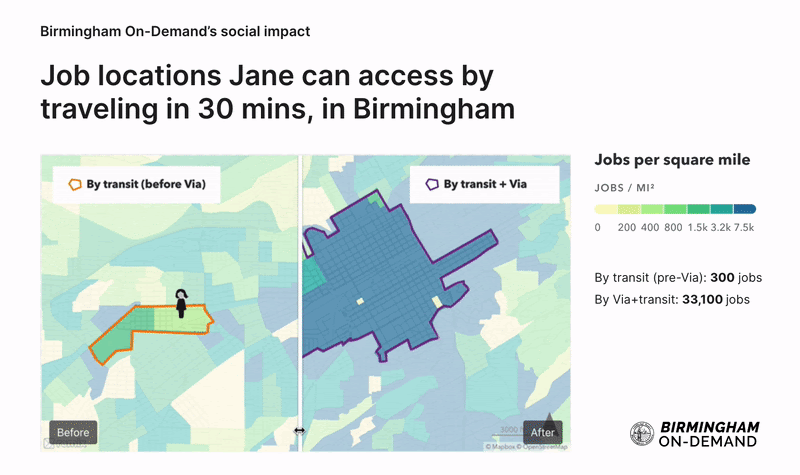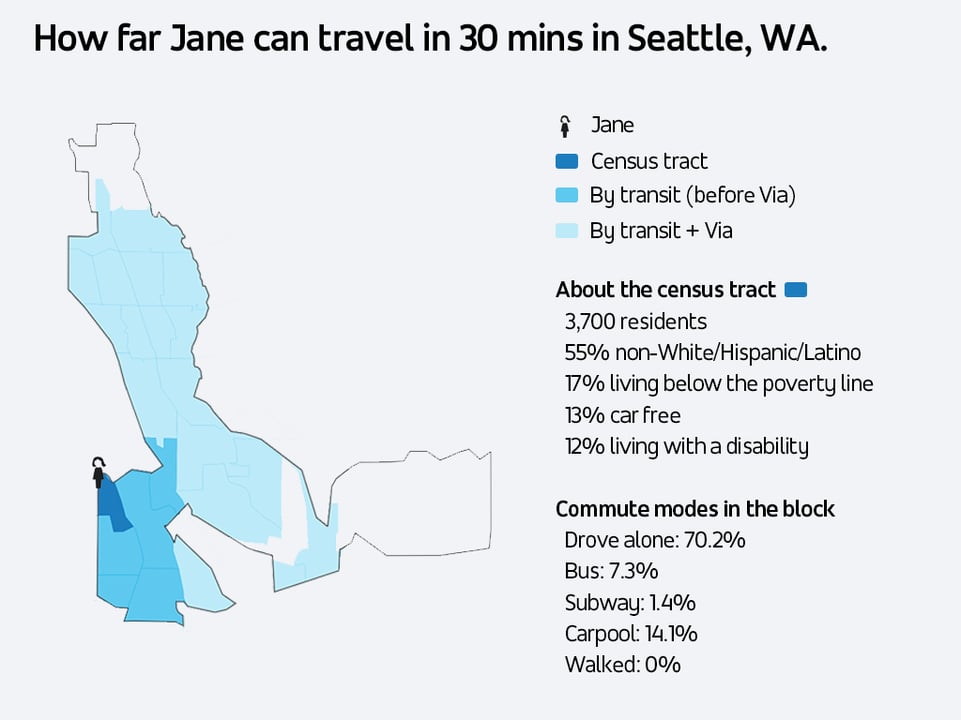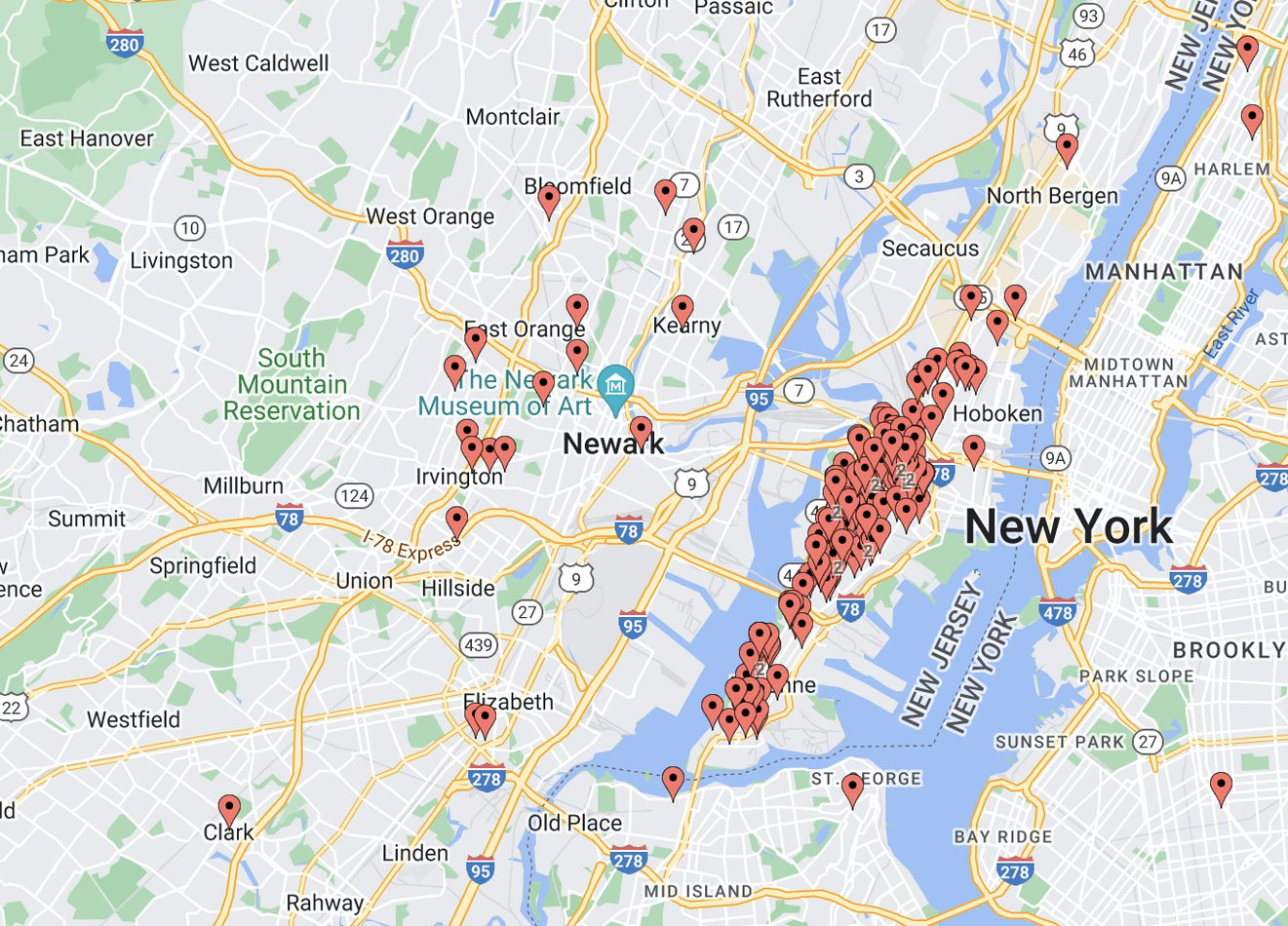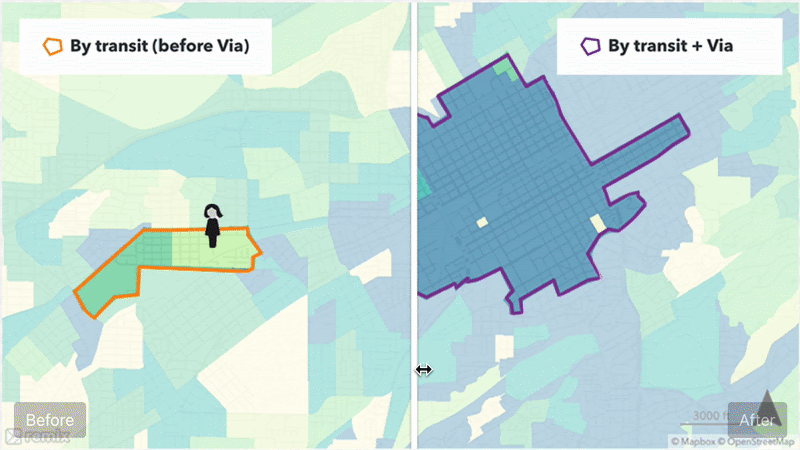- Every $1 invested in transit yields $4 in financial returns.
- 87% of transit trips directly benefit the economy by getting people to work and connecting them to local businesses.
Learn how to launch microtransit in your community
The answer is an unequivocal yes, according to a recent study by Via’s data science team. In 2022, the Via Affordable Access Report notes that Via-powered services in Seattle, Wilson, Birmingham, and hundreds of other US cities have increased access to jobs, schools, and healthcare by more than 40%.
Increasing job access in transit-dense and transit-light communities.
Microtransit’s positive impact is seen in communities of different demographic compositions — east to west, urban and rural, whether it’s a transit-dense or transit-light environment.
Birmingham, Alabama
Although Birmingham was already operating a robust public transportation system, local leadership was looking for new solutions to support some parts of the city that were historically underserved by public transit. In December 2019, the city launched Birmingham On-Demand, a microtransit service that provides affordable on-demand shared trips, with a key focus on selected areas of the city that are most in need. Before its launch, only 10% of the city’s jobs were accessible by public transportation. Now that number has increased to 90%.
Using Jane, Remix’s internal visualizer for evaluating service impact, we mapped what access to public transit looks like in a selected census tract — in other words, how far people can travel within 30 minutes by public transportation. The data shows that Birmingham On-Demand powered by Via has meaningfully increased transit coverage, connecting residents to 100x as many professional opportunities as before.

Mapped in Remix. Data viz credit: Manyu Jiang
As Jeremy McNair, a Birmingham On-Demand rider puts it, “since I’ve been using Birmingham On-Demand, I’ve been able to get to work on time…it’s a great reliable resource. It’s a game changer.”
Source: Our Community Foundation
Seattle, Washington
MetroFlex, an on-demand microtransit service with prominent first- and last-mile use cases operated by King County Metro, is augmenting the reach of Seattle’s existing transit network. Nearly 17% of Seattle’s residents reported living under the poverty line, and 13% do not have access to a personal car. With these circumstances, a simple trip can be hard to arrange and afford — which is where MetroFlex has stepped in.

The number of workplaces Jane could reach without Via was 12.8k. After the launch of the first MetroFlex zones, Jane could access as many as 45k jobs. Data viz credit: Manyu Jiang
Riders appreciate the new mobility freedom and the convenient access to jobs offered by MetroFlex, sharing with us how they benefit from increased access to KCM’s transit network. Sheldon, a frequent user of the service who lives in Seattle and works at the University of Washington, commutes home with Via to Transit. “It’s the time-saving and gas-saving and just the service in general,” he said when asked what he likes most about the service.
Elle, a South Seattle resident, works both at the airport and the University. She uses MetroFlex for its convenient access to other forms of public transportation. If the service didn’t exist, she would have to walk to her workplace. “It’s very helpful in the evening or morning, and sometimes I take my children,” she said.
Wilson, North Carolina
Microtransit helps fill gaps in less populated, rural areas as well, such as Wilson, North Carolina. RIDE — Wilson’s citywide on-demand microtransit service — supports job access both for standard commuters as well as for third-shift workers, who need to commute at non-traditional times of the day. Over half of riders reported that commuting is their most frequent reason for using RIDE. But of riders surveyed between 8 pm to 7 am, 75% reported that they were currently mid-commute, indicating that late-night service contributes significantly to job access. If solely dependent on fixed route services, riders can only access 5% of local workplaces; with on-demand, the number goes up to 80%.

17% of riders reported they would not have been able to make their last trip without RIDE, suggesting the service has made a meaningful difference in mobility access for the community. That includes people like Deanna Braswell, who doesn't have a car and relies on RIDE as her primary transportation to get to work at a local supermarket. “It's a blessing,” she told NPR in an interview. “It's my way of getting to work. It's my way of, you know, paying my bills.”
Accessing jobs, creating jobs.
Not only does microtransit help residents access jobs — it creates them as well. Since February 2020, Via Jersey City has been a lifeline to residents, unlocking their economic potential with affordable and reliable rides. During the pandemic, many essential workers depended on this flexible public transit to get to and from work which has kept communities running throughout the global crisis. Now, with PATH subway stations making up four of the top five destinations, this service has become a vital connection to the entire city-wide transit system. Commuting riders reported they enjoyed the service, citing cost and convenience, in a recent Bloomberg article.
The transit service not only creates better connectivity to jobs, but creates more jobs: 60% of Via Jersey City’s monthly active driver partners are from the city itself, and 80% are from the city and its surrounding towns in Hudson County, demonstrating innovations in public transit services can be part of the solution to improving employment.

Residency distribution of Via Jersey City’s monthly active driver partners.
Riding into the future with microtransit.
There’s a lot more to do to revitalize the economy, but seeing the opportunities brought by new mobility options can be a clear call to cities that transit for economic development is achievable and impactful. The success of microtransit programs provides a blueprint for just that. With its flexible operation mode, and high-quality rider experience customized to people’s unique needs, on-demand transportation can deliver a wide range of benefits to the communities it serves, driving economic development in numerous ways.

Data Journalist




%206.png?width=71&height=47&name=The%20Buzz%20Blog%20Hero%20(1750%20x%201200%20px)%206.png)